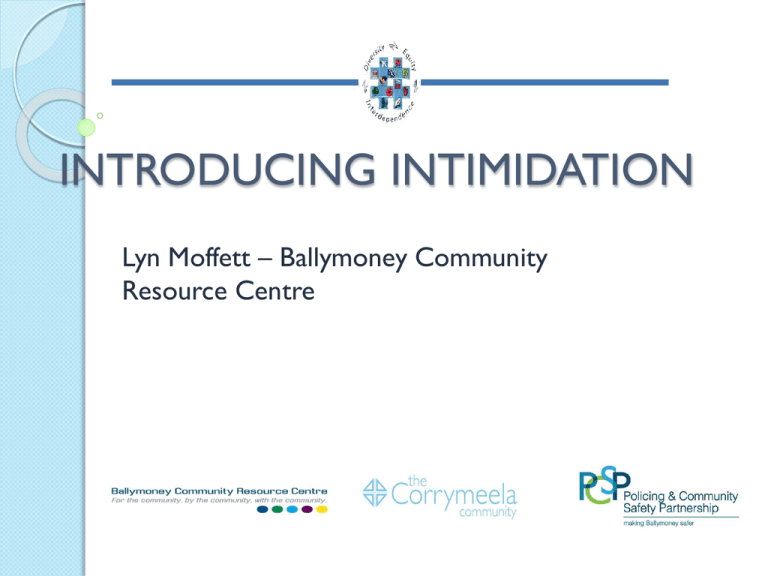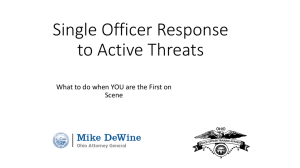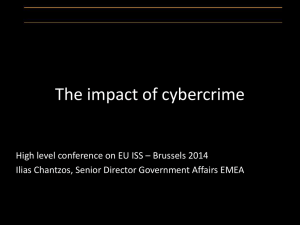INTRODUCING INTIMIDATION
advertisement

INTRODUCING INTIMIDATION Lyn Moffett – Ballymoney Community Resource Centre Defining Intimidation Intimidation is defined as the process by which, through the exercise of force or threat, or from a perception of threat, a person feels under pressure to do OR not do something against his or her will. It can be considered within a framework of three categories, acknowledging that they are not initially exclusive, or discrete: (1) actual physical harm; (2) actual threat; (3) perceived environmental threat. In all these settings it is clear that the victim's perception of what is happening is as important in determining responses as the intention of the perpetrator. What is perceived as a direct threat by one person can sometimes be dismissed as a chance occurrence by another. 1. Actual physical harm The most effective and direct form of intimidation is the use of force. This is not always a crude, indiscriminating weapon, but incorporates three main forms of violence: damage or destruction of property; injuring or disabling; and death It is possible to envisage the form of pressure moving systematically through these increasingly penal stages until the intended effect has been achieved. 2. Actual threat The threat of physical harm falls just short of the use of force as an effective form of intimidation. It is designed to induce fear of physical danger. Although no violence or destruction has taken place, the threat is sometimes sufficient to persuade its victims to leave their homes or jobs, or in extreme circumstances self harm or suicide. This type of psychological threat can take many forms, from a poison pen letter or anonymous telephone calls, bullets in the post, stalking, graffiti in public places, to masked men calling at the door. In today’s world social media is often used to bully and intimidate. This sort of pressure, like actual physical harm, is directed against specific individuals. It was and is one of the most common factors resulting in housing movement and forced re-homings. 3. Perceived environmental threat Specific environmental pressures include a variety of conditions within one's immediate community which create a feeling of unease or an impression that intimidation might occur, even though no specific threat has been made: neighbours becoming unfriendly; children finding it more difficult to find friends; silence in the face of anti-social behaviour or intimidation; an increase in the number of political or sectarian slogans on pavements or walls and an increase in other forms of territorial marking such as flags and murals. General environmental pressures result, not from changes within a community, but from pressure on the community itself. These pressures have been strong enough to produce enforced population movements, not because individuals have been attacked or threatened, but because the communities to which they belonged have themselves become isolated and vulnerable. Eg – large scale movement of the Protestant population from the city side in Derry/Londonderry The Toolkit Why do we think a toolkit is necessary? Research and development funded by CRC and Ballymoney PCSP Steering Group - call for volunteers Potential members of the Steering Group BCRC and WAVE PSNI and PCSP representatives Good Relations Practitioners Women’s Aid NIHE and Supporting Communities NI Act North West WINNI Potential Elements of the toolkit Definition of intimidation and types of intimidation Procedures for reporting intimidation The impact of intimidation on victims Responses to intimidation: by agencies by the group or individual Supporting victims Directory of support organisations A few examples of intimidation Domestic abuse Elder abuse Cyber bullying and Social Media Hate incidents/crimes Workplace bullying and intimidation Neighbourhood conflicts Paramilitary intimidation Organised crime/protectionism Human trafficking and sexual exploitation Next Steps Steering Group meets 13 January Research for toolkit Conference on Intimidation in February Compilation of toolkit Printing and dissemination







